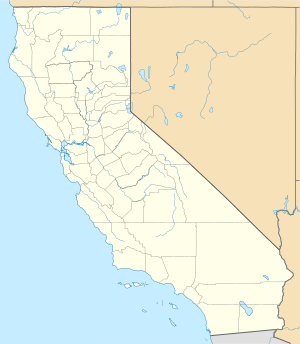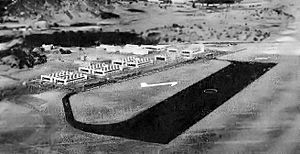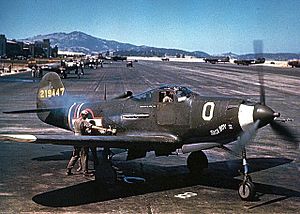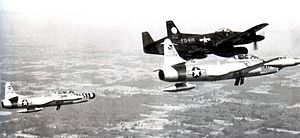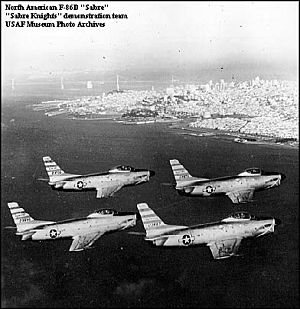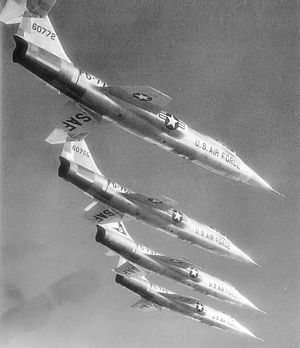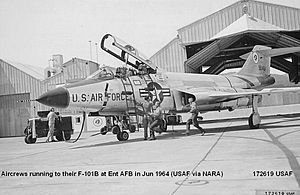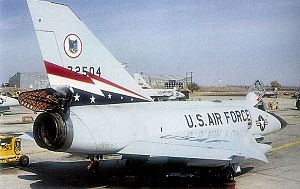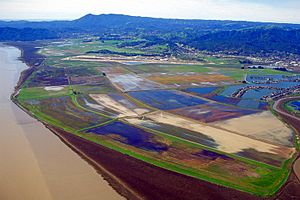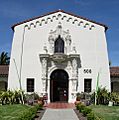Hamilton Army Airfield facts for kids
Quick facts for kids Hamilton Field/AFB/AAF |
|
|---|---|
| Part of Air/Aerospace Defense Command | |
| Located in Novato, California | |
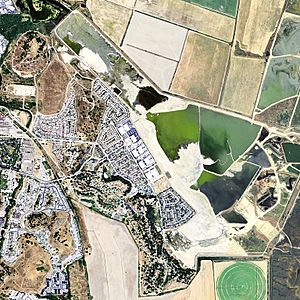
Hamilton Field, 2006 US Geological Survey photo
|
|
| Coordinates | 38°3′28″N 122°30′45″W / 38.05778°N 122.51250°W |
| Type | Air Force base |
| Site information | |
| Controlled by | United States Army Air Corps United States Army Air Forces United States Air Force United States Army |
| Site history | |
| Built | 1932–1935 |
| In use | 1934–1974 |
| Garrison information | |
| Garrison | Aerospace Defense Command |
Hamilton Field (also known as Hamilton AFB) was a military air base in California. It was used by the United States Air Force and later the United States Army. This important base was located along the San Pablo Bay in Novato, Marin County, California. It was officially closed in 1988.
Contents
What is Hamilton Field?
Hamilton Field was a military air base. It was named after First Lieutenant Lloyd Andrews Hamilton. He was a brave pilot in World War I. He earned a special award for his courage in Belgium in 1918. Sadly, he died in action shortly after.
How did Hamilton Field start?
The idea for Hamilton Air Force Base began in the late 1920s. People called it by different names at first. These included Marin County Air Field. The official name, Hamilton Field, was given on July 12, 1932.
Building the airfield started around July 1932. It was designed to hold many bomber planes and their crews. Captain Don L. Hutchins became the first commander in June 1933. The first group of airmen arrived in December that year. The main construction was finished in May 1935.
What kind of planes were at Hamilton Field?
Hamilton Field first housed bomber planes. In May 1934, Martin B-10 and B-12 bombers arrived. These planes were later replaced by the Douglas B-18 Bolo in 1937. The B-18 could carry troops, which was a big step forward in combat.
Later, bigger planes like the Boeing B-17 Flying Fortress were developed. These planes needed longer runways. Since Hamilton Field's runway was not big enough, the B-17s had to go to other bases.
Hamilton Field's fighter planes
In December 1940, Hamilton Field became a base for fighter planes. It was home to several "Pursuit Wings." These groups flew planes like the Curtiss P-40 Warhawk. Other planes included the Republic P-43 Lancer and older Curtis P-36 Mohawks.
The base became very crowded with all the new planes and pilots. On December 7, 1941, Hamilton was made an air defense base for the West Coast.
The attack on Pearl Harbor
On December 6, 1941, a group of B-17 bombers left Hamilton Field. They were flying to the Philippines to help American forces there. They were not armed. The next morning, December 7, 1941, they arrived over Oahu, Hawaii.
They arrived during the Japanese attack on Pearl Harbor. Radar operators mistakenly thought the Japanese planes were these bombers. The B-17s faced a dangerous welcome. Some managed to land safely, but others landed under attack. This event led to the United States joining World War II.
Hamilton Field during World War II
During World War II, Hamilton Field was a very important training base. It trained new fighter groups. The base quickly grew with more barracks, dining halls, and other buildings.
Many fighter groups trained at Hamilton Field. They flew planes like the P-38 "Lightning", P-39 "Airacobra", and P-51 "Mustang".
- 78th Fighter Group (May 1942 – November 1942) flew P-38 "Lightning"
- 354th Fighter Group (November 1942 – January 1943) flew P-39 "Airacobra"
- 357th Fighter Group (December 1942 – March 1943) flew P-51 "Mustang"
- 363rd Fighter Group (March 1943 – August 1943) flew P-39 "Airacobra"
- 367th Fighter Group (July 1943 – October 1943) flew P-38 "Lightning"
Hamilton also served as a major hub for moving troops and supplies. These went to the Pacific and other war zones.
After the war
After World War II, Hamilton Field continued to be important. It was a main base for moving troops home. It also became a key location for air defense.
Air Defense Command
The Air Defense Command (ADC) became the main user of Hamilton Field. The base was the headquarters for defending the Pacific Coast.
Fighter planes at Hamilton Field
The 325th Fighter Group was the first major ADC unit at Hamilton. They flew P-61 Black Widow planes. These were later replaced by the F-82F Twin Mustang in 1948.
The 78th Fighter Wing took over in 1948. They flew F-51D Mustangs and Republic F-84B Thunderstreaks. Their job was to defend the Pacific coast.
The "Sabre Knights"
In the 1950s, the 83rd and 84th Fighter-Interceptor Squadrons flew F-86D Sabre planes. The 325th Fighter-Interceptor Squadron had an aerial demonstration team called the "Sabre Knights." They showed off their flying skills.
Newer fighter jets
In 1958, the 83rd Fighter Interceptor Squadron received the F-104A Starfighter. This jet was very fast. However, it couldn't fly for very long and wasn't great in all weather.
The F-104As were replaced by the McDonnell F-101B Voodoo in 1959-1960. The F-101B was a more successful interceptor.
The Convair F-106A Delta Dart replaced the F-101 in 1968. Many people thought the F-106 was the best all-weather interceptor ever built. It served at Hamilton until 1987.
NORAD and the end of the fighter mission
In 1966, Hamilton AFB became the headquarters for the Western NORAD Region. NORAD is a joint defense command between the U.S. and Canada. It was responsible for air defense in 11 western states and parts of Canada.
The 84th Fighter Interceptor Squadron continued to fly the F-106. However, as the Vietnam War ended, the base began to close. The 84th FIS moved to another base in 1973. This move effectively ended Hamilton AFB's role in air defense.
Air Force Reserve Units
Hamilton AFB was also home to Air Force Reserve units. These units included the 349th Military Airlift Wing. This wing was activated in 1949. It flew transport planes like the Curtiss-Wright C-46 Commando.
During the Korean War, reserve personnel from the 349th were called to active duty. The unit was later reactivated as a fighter-bomber wing. It flew planes like the North American F-51 Mustang and Republic F-84 Thunderstreak.
The 349th later became a Troop Carrier Wing. It flew the Fairchild C-119 Flying Boxcar. This unit was ready to move quickly. It was called to active duty during the Cuban Missile Crisis in 1962.
Later, the 349th became the 349th Military Airlift Wing. It flew the Douglas C-124 Globemaster II. During the Vietnam War, this wing transported thousands of tons of cargo. It supported U.S. forces across the Pacific. In 1969, the 349th MAW moved to Travis AFB.
Another reserve unit, the 452d Military Airlift Wing, moved to Hamilton in 1972. It flew C-130B Hercules planes. This wing became the "host wing" for Hamilton AFB in 1973.
Closure of Hamilton Field
The active Air Force stopped using Hamilton Field after October 1973. Many facilities were given to the U.S. Army. The U.S. Coast Guard also moved into some hangars.
The 452d TAW operated at a low level until 1976. An agreement was made to close Hamilton as part of the military's reduction after the Vietnam War. The base was then put into a "caretaker status."
From 1980 to 1983, Hamilton AFB was a Refugee Transit Center. It helped process refugees from countries like Vietnam and Afghanistan. Many thousands of refugees stayed there temporarily.
In 1988, the base was officially closed. The land was transferred for public and private use. The name was changed back to "Hamilton Field." The Navy also left its housing at Hamilton in 1996.
What is Hamilton Field like today?
Today, much of the former airfield has been taken over by the city of Novato. Many old buildings have been removed. New homes have been built.
The airfield is also part of a big project to restore wetlands. This project is called the Hamilton Wetland Restoration Project. It helps bring back natural habitats.
Some of the original hangars have been turned into offices. They still look the same from the outside. Other original buildings, like the old headquarters, have been renovated. The TV show MythBusters used hangar space here for some experiments. Parts of movies like Indiana Jones and the Temple of Doom and The Right Stuff were also filmed at Hamilton.
The U.S. Coast Guard still owns many old Spanish-style homes there. These were part of the original base housing.
Building style
The buildings at Hamilton Field were built in the 1930s. Captain Howard B. Nurse designed them. He used a popular style called Spanish eclectic. This style made the buildings look like old California missions. They have stucco walls, tile roofs, and decorative ironwork.
Gallery
-
Hospital building in the Spanish Revival style


